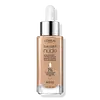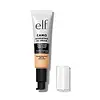What's inside
What's inside
 Key Ingredients
Key Ingredients

 Benefits
Benefits

 Concerns
Concerns

 Ingredients Side-by-side
Ingredients Side-by-side

Water
Skin ConditioningIsododecane
EmollientDimethicone
EmollientAlcohol Denat.
AntimicrobialTrimethylsiloxysilicate
EmollientButylene Glycol
HumectantPEG-10 Dimethicone
Skin ConditioningPerlite
AbsorbentSodium Hyaluronate
HumectantNylon-12
Isopropyl Lauroyl Sarcosinate
Skin ConditioningDiisopropyl Sebacate
EmollientDisteardimonium Hectorite
StabilisingHdi/Trimethylol Hexyllactone Crosspolymer
Bis-PEG/PPG-14/14 Dimethicone
EmollientMagnesium Sulfate
Synthetic Fluorphlogopite
Ethylhexyl Hydroxystearate
EmollientPhenoxyethanol
PreservativeCellulose
AbsorbentDipentaerythrityl Tetrahydroxystearate/Tetraisostearate
Skin ConditioningSilica
AbrasiveSilica Silylate
EmollientDisodium Stearoyl Glutamate
CleansingCalcium Carbonate
AbrasiveCalcium Aluminum Borosilicate
Tocopherol
AntioxidantMoroccan Lava Clay
AbrasiveGlycerin
HumectantEmpetrum Nigrum Fruit Juice
Skin ConditioningAluminum Hydroxide
EmollientPotassium Sorbate
PreservativeCI 77491
Cosmetic ColorantCI 77492
Cosmetic ColorantCI 77499
Cosmetic ColorantCeramide AP
Skin ConditioningWater, Isododecane, Dimethicone, Alcohol Denat., Trimethylsiloxysilicate, Butylene Glycol, PEG-10 Dimethicone, Perlite, Sodium Hyaluronate, Nylon-12, Isopropyl Lauroyl Sarcosinate, Diisopropyl Sebacate, Disteardimonium Hectorite, Hdi/Trimethylol Hexyllactone Crosspolymer, Bis-PEG/PPG-14/14 Dimethicone, Magnesium Sulfate, Synthetic Fluorphlogopite, Ethylhexyl Hydroxystearate, Phenoxyethanol, Cellulose, Dipentaerythrityl Tetrahydroxystearate/Tetraisostearate, Silica, Silica Silylate, Disodium Stearoyl Glutamate, Calcium Carbonate, Calcium Aluminum Borosilicate, Tocopherol, Moroccan Lava Clay, Glycerin, Empetrum Nigrum Fruit Juice, Aluminum Hydroxide, Potassium Sorbate, CI 77491, CI 77492, CI 77499, Ceramide AP
Zinc Oxide 6.3%
Cosmetic ColorantTitanium Dioxide 6%
Cosmetic ColorantHomosalate 5%
Skin ConditioningEthylhexyl Salicylate 4.5%
UV AbsorberOctocrylene 3%
UV AbsorberWater
Skin ConditioningDimethicone
EmollientButylene Glycol
HumectantCetyl PEG/PPG-10/1 Dimethicone
EmulsifyingButyloctyl Salicylate
Skin ConditioningButylene Glycol Dicaprylate/Dicaprate
EmollientPanthenol
Skin ConditioningSynthetic Fluorphlogopite
Polyglyceryl-4 Isostearate
EmulsifyingMagnesium Sulfate
Acrylates/Polytrimethylsiloxymethacrylate Copolymer
Skin ConditioningTrehalose
HumectantPhenoxyethanol
PreservativeHydrated Silica
AbrasiveDisteardimonium Hectorite
StabilisingTriethoxycaprylylsilane
Hydrogen Dimethicone
Aluminum Hydroxide
EmollientTriethyl Citrate
MaskingEthylhexylglycerin
Skin ConditioningCaprylyl Glycol
EmollientDisodium EDTA
Tin Oxide
AbrasiveTocopheryl Acetate
AntioxidantTremella Fuciformis Extract
HumectantSodium Hyaluronate
HumectantNiacinamide
SmoothingAscorbyl Palmitate
AntioxidantCanola Oil
EmollientGlycerin
HumectantDaucus Carota Sativa Seed Oil
Emollient1,2-Hexanediol
Skin ConditioningDaucus Carota Sativa Root Extract
Skin ConditioningHelianthus Annuus Seed Oil
EmollientBeta-Carotene
Skin ConditioningSoluble Collagen
HumectantCI 77891
Cosmetic ColorantCI 77492
Cosmetic ColorantCI 77491
Cosmetic ColorantCI 77499
Cosmetic ColorantZinc Oxide 6.3%, Titanium Dioxide 6%, Homosalate 5%, Ethylhexyl Salicylate 4.5%, Octocrylene 3%, Water, Dimethicone, Butylene Glycol, Cetyl PEG/PPG-10/1 Dimethicone, Butyloctyl Salicylate, Butylene Glycol Dicaprylate/Dicaprate, Panthenol, Synthetic Fluorphlogopite, Polyglyceryl-4 Isostearate, Magnesium Sulfate, Acrylates/Polytrimethylsiloxymethacrylate Copolymer, Trehalose, Phenoxyethanol, Hydrated Silica, Disteardimonium Hectorite, Triethoxycaprylylsilane, Hydrogen Dimethicone, Aluminum Hydroxide, Triethyl Citrate, Ethylhexylglycerin, Caprylyl Glycol, Disodium EDTA, Tin Oxide, Tocopheryl Acetate, Tremella Fuciformis Extract, Sodium Hyaluronate, Niacinamide, Ascorbyl Palmitate, Canola Oil, Glycerin, Daucus Carota Sativa Seed Oil, 1,2-Hexanediol, Daucus Carota Sativa Root Extract, Helianthus Annuus Seed Oil, Beta-Carotene, Soluble Collagen, CI 77891, CI 77492, CI 77491, CI 77499
 Reviews
Reviews

Ingredients Explained
These ingredients are found in both products.
Ingredients higher up in an ingredient list are typically present in a larger amount.
Aluminum Hydroxide is a form of aluminum. It can be naturally found in nature as the mineral gibbsite. In cosmetics, Aluminum Hydroxide is used as a colorant, pH adjuster, and absorbent.
As a colorant, Aluminum Hydroxide may add opacity, or reduce the transparency. Aluminum hydroxide is contains both basic and acidic properties.
According to manufacturers, this ingredient is an emollient and humectant. This means it helps hydrate the skin.
In medicine, this ingredient is used to help relieve heartburn and help heal ulcers.
There is currently no credible scientific evidence linking aluminum hydroxide in cosmetics to increased cancer risk.
Major health organizations allow the use of aluminum hydroxide in personal care products and have not flagged it as a carcinogenic risk at typical usage levels.
Learn more about Aluminum HydroxideButylene Glycol (or BG) is used within cosmetic products for a few different reasons:
Overall, Butylene Glycol is a safe and well-rounded ingredient that works well with other ingredients.
Though this ingredient works well with most skin types, some people with sensitive skin may experience a reaction such as allergic rashes, closed comedones, or itchiness.
Learn more about Butylene GlycolCi 77491 is also hydrated iron III oxide. It's sole purpose is to give a red/pink hue to products.
Iron III oxides are classified as inorganic chemicals for coloring.
Synthetically created Ci 77491 is considered safer than those naturally found. This is because the synthetically created version may contain less impurities. Iron oxides are generally non-toxic and non-allergenic.
Learn more about CI 77491Ci 77492 is also hydrated iron III oxide. It's sole purpose is to give a yellow hue to products.
Iron III oxides are classified as inorganic chemicals for coloring.
Synthetically created Ci 77492 is considered safer than those naturally found. This is because the synthetically created version may contain less impurities. Iron oxides are generally non-toxic and non-allergenic.
Learn more about CI 77492Ci 77499 is also hydrated iron III oxide. It is created from mixing red and black iron oxides. This helps give shades of darkness to a product.
Iron III oxides are classified as inorganic chemicals for coloring.
Dimethicone is a type of synthetic silicone created from natural materials such as quartz.
What it does:
Dimethicone comes in different viscosities:
Depending on the viscosity, dimethicone has different properties.
Ingredients lists don't always show which type is used, so we recommend reaching out to the brand if you have questions about the viscosity.
This ingredient is unlikely to cause irritation because it does not get absorbed into skin. However, people with silicone allergies should be careful about using this ingredient.
Note: Dimethicone may contribute to pilling. This is because it is not oil or water soluble, so pilling may occur when layered with products. When mixed with heavy oils in a formula, the outcome is also quite greasy.
Learn more about DimethiconeDisteardimonium Hectorite comes from the clay mineral named hectorite. It is used to add thickness to a product.
It can also help stabilize a product by helping to disperse other ingredients.
Hectorite is a rare, white clay mineral.
Learn more about Disteardimonium HectoriteGlycerin is already naturally found in your skin. It helps moisturize and protect your skin.
A study from 2016 found glycerin to be more effective as a humectant than AHAs and hyaluronic acid.
As a humectant, it helps the skin stay hydrated by pulling moisture to your skin. The low molecular weight of glycerin allows it to pull moisture into the deeper layers of your skin.
Hydrated skin improves your skin barrier; Your skin barrier helps protect against irritants and bacteria.
Glycerin has also been found to have antimicrobial and antiviral properties. Due to these properties, glycerin is often used in wound and burn treatments.
In cosmetics, glycerin is usually derived from plants such as soybean or palm. However, it can also be sourced from animals, such as tallow or animal fat.
This ingredient is organic, colorless, odorless, and non-toxic.
Glycerin is the name for this ingredient in American English. British English uses Glycerol/Glycerine.
Learn more about GlycerinMagnesium Sulfate is a salt. More specifically, it is an epsom salt, or the bath salt used to help relieve muscle aches.
Despite having ‘sulfate’ in the name, it isn’t a surfactant or cleansing agent like sodium lauryl sulfate. Unlike those sulfates, magnesium sulfate doesn’t have the same cleansing or foaming properties (it's simply a type of salt).
In cosmetics, Magnesium Sulfate is used to thicken a product or help dilute other solids. It is a non-reactive and non-irritating ingredient.
One study shows magnesium deficiency may lead to inflammation of the skin. Applying magnesium topically may help reduce inflammation.
You can find this ingredient in sea water or mineral deposits.
Learn more about Magnesium SulfatePhenoxyethanol is a preservative that has germicide, antimicrobial, and aromatic properties. Studies show that phenoxyethanol can prevent microbial growth. By itself, it has a scent that is similar to that of a rose.
It's often used in formulations along with Caprylyl Glycol to preserve the shelf life of products.
Sodium Hyaluronate is hyaluronic acid's salt form. It is commonly derived from the sodium salt of hyaluronic acid.
Like hyaluronic acid, it is great at holding water and acts as a humectant. This makes it a great skin hydrating ingredient.
Sodium Hyaluronate is naturally occurring in our bodies and is mostly found in eye fluid and joints.
These are some other common types of Hyaluronic Acid:
Learn more about Sodium HyaluronateSynthetic Fluorphlogopite is the synthethic version of mica. It consists of fluorine, aluminum and silicate.
Synthetic Fluorphlogopite is used to add volume to products.
It is considered non-irritating on the skin.
Learn more about Synthetic FluorphlogopiteWater. It's the most common cosmetic ingredient of all. You'll usually see it at the top of ingredient lists, meaning that it makes up the largest part of the product.
So why is it so popular? Water most often acts as a solvent - this means that it helps dissolve other ingredients into the formulation.
You'll also recognize water as that liquid we all need to stay alive. If you see this, drink a glass of water. Stay hydrated!
Learn more about Water